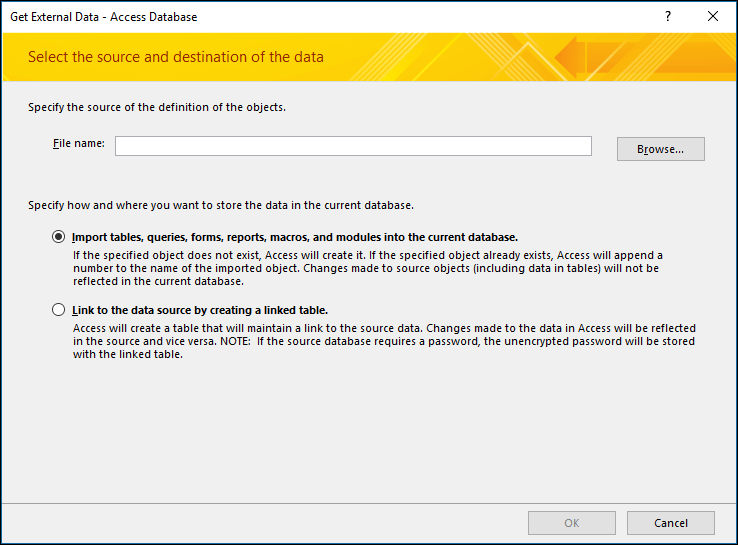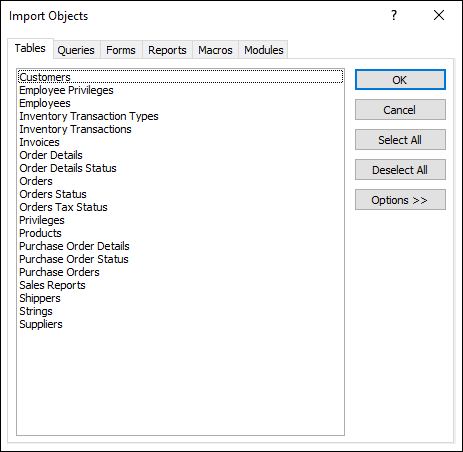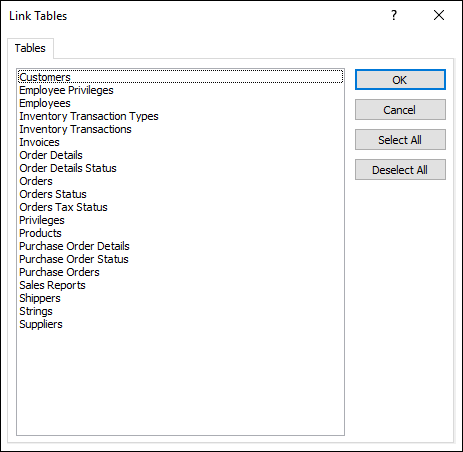How To Upload Data To Access Table With Multiselect Fields Defined
You can bring information from one Access database into another in many ways. Copying and pasting is the simplest method, but importing and linking offer yous amend control and flexibility over the data that you lot bring, and over how you bring that data into the destination database.
This article explains how to import or link to data in some other Access database.
What do you lot want to do?
-
Empathise importing and linking to data from another Admission database
-
Import information from some other Admission database
-
Link to data in some other Admission database
Understand importing and linking to data from another Access database
When you import from another database, Admission creates a re-create of the information in the destination database without altering the source. During the import functioning, you can choose the objects y'all want to copy, control how tables and queries are imported, specify whether relationships betwixt tables should be imported, and then on.
You might want to import data for instance to create some tables that are similar to tables that be in another database. Y'all might want to re-create the entire tabular array or merely the table definitions to avoid manually designing each of these tables. When you choose to import only the table definition, you become an empty table. In other words, the fields and field backdrop are copied to the destination database, just not the data in the table. Some other reward of importing (compared to a re-create-paste operation) is that you can cull to import the relationships betwixt the tables along with the tables themselves.
If your goal is to add records from ane database to an existing table in some other database, you should consider importing the records to a new tabular array and and so creating an suspend query. You cannot suspend records to an existing tabular array during an import operation. For more than data nearly append queries, see the article Add records to a tabular array past using an append query.
You might want to link to data in another Access database if your organization uses several Access databases, just data in some tables, such every bit Employees, need to be shared between various databases. Instead of duplicating the table in each such database, you tin can continue the table in a unmarried database and link to it from other databases. Another workgroup or department needs to exist able to add together to and use the data in your database, but you want to go along to ain the construction of the tables.
Import data from another Access database
The process of importing data follows these general steps:
-
Prepare for the import operation
-
Run the Import Magician
-
Optionally save the import settings as an import specification for later reuse
The following sets of steps explain how to perform each activeness.
Prepare for the import performance
-
Locate the source database and place the objects that y'all desire to import.
If the source database is an .mdb or .accdb file, you can import tables, queries, forms, reports, macros, and modules. If the source file is an .mde or .accde file, you tin can import only tables.
-
If this is the get-go time you are importing data from an Access database, refer to the post-obit table for some useful tips.
Element
Description
Multiple objects
Y'all can import multiple objects in a unmarried import operation.
New object
Each import functioning creates a new object in the destination database. You cannot overwrite an existing object or append records to an existing tabular array by using an import operation.
Importing a linked table
If the source table (for instance, Employees1 in the Sales database) is really a linked table (a table that links to the Employees table in the Payroll database), the current import operation is replaced past a linking operation. At the end of the operation, you volition run across a linked table (named, for example, Employees1) that links to the original source table (Employees in the Payroll database).
Skipping fields and records
Y'all cannot skip specific fields or records when importing data from a table or query. However, if you do not want to import any of the records in a table, you tin can choose to import simply the tabular array definition.
Relationships
You can choose to import the relationships between source tables.
Tabular array definition
You tin choose to import an entire table or merely the tabular array definition. When you import but the definition, Access creates a table that has the same fields as the source table, but no data.
Lookup fields
If a field in the source table looks up values in another table or query, you lot must import the related tabular array or query if you desire the destination field to display lookup values. If you do non import the related table or query, the destination field volition only display the lookup IDs.
Queries
You can import a query either every bit a query or as a tabular array. If you import a query as a query, then yous must import the underlying tables.
-
Close the source database. Ensure that no user has information technology open in exclusive fashion.
-
Open the destination database. Ensure that the database is non read-merely and that you take the necessary permissions to add objects and data to the database.
If the source database is password protected, y'all are prompted to enter the password each time y'all use information technology equally a source for an import operation.
Note:If you want to import the data into a new database, you must create a bare database that does not contain any tables, forms, or reports before starting the import functioning.
The import operation does not overwrite or change any of the existing tables or objects. If an object with the aforementioned name as the source object already exists in the destination database, Access appends a number (1, 2, 3, and so on) to the proper name of the import object. For example, if y'all import the Issues table to a database that already has a table named Issues, the imported table volition be named Issues1. If the name Issues1 is already in use, the new table will be named Issues2, and so on.
It is important to note that if you want to append the records in the source table to a table in the destination database, you must use an append query instead of running an import performance. For more than data near append queries, see the article Add records to a tabular array by using an append query.
Import the data
-
The location of the import sorcerer differs slightly depending upon your version of Access. Choose the steps that lucifer your Admission version:
-
If yous're using the latest version of the Microsoft 365 subscription version of Access, on the External Data tab, in the Import & Link group, click New Data Source > From Database > Access.
-
If you're using Admission 2016, Admission 2013 or Access 2010, on the External Data tab, in the Import & Link group, click Access.
-
-
The Get External Data - Access Database import and link wizard opens.

-
In the File proper name text box, type the name of the source database or click Scan to brandish the File Open dialog box.
-
Select Import tables, queries, forms, reports, macros, and modules into the current database and click OK.
The Import Objects dialog box opens.

-
In the Import Objects dialog box, on the Tables tab, select the tables yous want to import. If you desire to import queries, click the Queries tab and select the queries you want to import.
To abolish a selected object, click the object once more.
-
Click Options to specify additional settings.
The following table describes how each option impacts the results of the performance.
Element
Description
Relationships check box
Select to import the relationships betwixt the selected tables.
Menus and Toolbars check box
Select to import any custom menus and toolbars that exist in the source database. The menus and toolbars are displayed on a tab named Add-Ins.
Import/Export Specs cheque box
Select to import any saved import or consign specifications that be in the source database.
Nav Pane Groups cheque box
Select to import any custom Navigation pane groups that exist in the source database.
Definition and Data selection button
Select to import the structure and information of all selected tables.
Definition Simply option button
Select to import only the fields in the selected tables. The source records are non imported.
As Queries choice button
Select to import the selected queries equally queries. In this instance, call up to import all the underlying tables along with the queries.
As Tables option push
Select to import queries as tables. In this example, you lot need not import the underlying tables.
-
Click OK to finish the operation.
Access copies the information and displays fault messages if it encounters any problems. If the functioning succeeds in importing the data, the final page of the wizard allows you to salve the details of the operation every bit an import specification for hereafter apply.
Link to information in another Admission database
Linking lets you connect to data in another database without importing it, and so that yous can view and modify the latest data in both the source and destination databases without creating and maintaining two copies of the aforementioned data. You tin can link only to tables in another Admission database. You cannot link to queries, forms, reports, macros, or modules.
When y'all link to a table in an Access database, Access creates a new tabular array, chosen a linked table, which maintains a link to the source records and fields. Whatsoever changes you brand to the data in the source database are reflected in the linked table in the destination database, and vice versa. However, you cannot modify the structure of a linked table in the destination database. In other words, you cannot brand changes to a linked table such as adding or deleting a field, or modifying the data type of a field.
The procedure of linking to data in some other Access database follows these general steps:
-
Fix for the link operation
-
Run the Link Wizard
The following sets of steps explicate how to perform each activity.
Prepare to link tables in an Access database
-
Locate the source database.
The file format tin exist MDB, MDE, ACCDB, or ACCDE. If the source database is password protected, y'all will be prompted to enter the password during the linking operation.
-
Identify the tables to which you want to link. Yous tin link to tables, simply yous cannot link to queries, forms, reports, macros, or modules. If this is the first time you lot are linking to tables in another Access database, refer to the following table for some useful tips.
Chemical element
Description
Multiple objects
You tin can create links to multiple tables in a single linking operation. A linked table is created for each source tabular array.
Linked tables as source
You cannot link to a table that is already a linked table in the source database.
For example, if the Employees1 tabular array that you lot desire to link to in the Sales database is actually a linked table that links to the Employees table in the Payroll database, yous cannot use the Employees1 table in the Sales database as the source table. You should instead link straight to the Employees tabular array in the Payroll database.
New or existing table
Each linking operation creates a new linked table for each source table. You cannot overwrite or append to an existing table by using a linking functioning.
Relationships
If you select multiple source tables, the relationships between the tables are automatically carried forward to the destination database. Yet, y'all cannot change or delete the relationship in the destination database.
Lookup fields
If a field in the source tabular array looks up values in some other table, you lot must remember to link to the related table if you want the destination field to brandish lookup values. If yous do not link to the related table or query, the destination field merely displays the lookup IDs.
-
Shut the source database. Ensure that no other user has the database open in exclusive mode.
-
Open the destination database. Ensure that the destination database is non read-just and that you take the necessary permissions to add objects and data to the database.
Note:If you want to create the links in a new database, you lot must create a bare database (one that does not contain any tables, forms, or reports) before starting the link operation.
The operation does not overwrite or modify any of the existing tables or objects. If an object with the same name every bit the source object already exists in the destination database, Access appends a number (i, 2, three, and then on) to the name of the linked tabular array. For instance, if you link to the Issues table from a database that already has a table named Problems, the linked tabular array volition exist named Issues1. If the name Issues1 is already in utilize, the new table volition exist named Issues2, and then on.
Remember that if yous want to append the records in the source tabular array to a tabular array in the destination database, yous must apply an append query instead of running a linking performance.
For more information about suspend queries, see the article Add records to a table by using an append query.
Link to the information
-
The location of the link magician differs slightly depending upon your version of Access. Choose the steps that friction match your Access version:
-
If you lot're using the latest version of the Microsoft 365 subscription version of Access, on the External Data tab, in the Import & Link grouping, click New Data Source > From Database > Admission.
-
If you lot're using Access 2016, Access 2013 or Access 2010, on the External Data tab, in the Import & Link group, click Access.
-
-
The Get External Information - Access Database import and link wizard opens.

-
In the File name text box, type the name of the source database or click Browse to display the File Open dialog box.
-
Click Link to the information source by creating a linked table, and and then click OK.
The Link Tables dialog box opens.

-
In the Link Tables dialog box, select the tables you desire to link to.
To cancel a choice, click the table again.
-
Click OK to finish the operation.
Access creates the linked tables.
-
Open up the linked tables in Datasheet view to ensure that the data looks right.
What else should I know?
-
For information on how to salvage the details of your import into a specification that y'all can reuse later, see the article Salvage the details of an import or export performance every bit a specification.
-
For information on how to run saved import specifications, see the article Run a saved import or export functioning.
-
For data on how to schedule specifications to run at specific times, come across the article Schedule an import or export operation.
-
For information on how to modify a specification proper name, delete specifications, or update the names of source files in specifications, see the article Manage Data Tasks.
Tiptop of Page
Source: https://support.microsoft.com/en-us/office/import-or-link-to-data-in-another-access-database-095ab408-89c7-45b3-aac2-58036e45fcf6
Posted by: andersonobecam.blogspot.com

0 Response to "How To Upload Data To Access Table With Multiselect Fields Defined"
Post a Comment